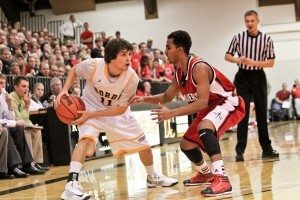In the five prior articles in our basketball defending series we’ve covered a lot of ground including some thoughts on defending the screen/roll-pop. In an earlier article, we essentially shared thoughts on defending the dribble drive. While those two trends seem to dominate current offensive thinking, there are other actions that warrant discussion.
Basketball Defending Series: Flex Cuts, DHO’s and Pin Down
For all practical purposes, the flex isn’t utilized as an offense at the college level any more because of the shot clock, but it is often used as a play, or quick hitter at that level. However, the flex is still widely used at the high school level because of the strength of the 3-man action upon the “guard-guard” reversal.
My thoughts on defending the flex are very simple. If the defender on the corner/wing man is denying or hugging that man, he is susceptible to being back-screened by the offensive man on that same block. This circumstance now requires the defender on the screener to “show” until the corner/wing defender can recover. That puts the screener’s defender in peril to give up the elbow jump shot when his man receives the corresponding down screen from the man at the elbow who reverses the ball. You know the continuity. In theory, if you take away the cut, you give up the jump shot; if you take away the jump shot, you give up the cut.
Now, there are a lot ways to defend the flex but the simplest way to not get beat by either the flex cut for a layup OR an open elbow jump shot after the downscreen- is to sag off the first corner/wing man and every subsequent corner/wing man. That way, the corner defender can get over the backscreen by himself and deny the cut AND then, since the backscreener’s defender doesn’t have to help the corner/wing man’s defender, he’s more free to fight over the subsequent downscreen by himself to get a tie on the catch. One might argue that if the corner/wing defender is sagged off, he’ll always be open for a strong side pass. That’s true but the defender should only sag off enough to defend the flex cut AND “get a tie on the catch” to that man.
If the flex is thwarted on those essential actions, it has to go to far less dangerous options. If the 3-man action is being defended in this manner, the defenders on top can pressure the ball. Generally flex offenses are very uncomfortable with ball pressure on top because the players aren’t encouraged or allowed to stray from the continuity and drive the ball.
Dribble Hand-Offs
Back in the day, dribble hand-offs only occurred between guards (and skilled forwards) and handoffs were totally off dribble movement (the dribbler didn’t stop). We called it a weave. To defend, if the weave action is above the arc, every defender can go under the handoff. If the action is at the arc or under, the handoffs can be switched and the helpside defenders are mostly responsible for backdoor cuts. (Some teams add a high post screener to add another dimension. This can be handled by our normal hedge thinking.)
With the influx of screen/roll-pop offenses, dribble handoffs took on a new dimension- a big/small handoff. If this is a stationary handoff (when the dribbler stops), it can be handled with normal hedge defense. If it is a “weave” handoff, it can be handled by going under the handoff outside the arc. At or inside the arc, you have a choice to go under or switch depending on your opponent’s big’s shooting ability or your comfort level of contending with a possible mismatch.
Down Screens and Rub Screens
While backscreens aren’t as popular and widespread as they once were, downscreens (when the screener has moved) and rub screens (where the screener is already stationary in the low post area) are still widely utilized.
This action also requires the screener’s defender to show and recover but it is potentially more dangerous than the high screen/roll because of the screener’s proximity to the basket. Any mistake can lead to a layup quite easily. Again, the helpside defenders are the key. If they are in place, the screener’s defender can be aggressive in helping his teammate get over the screen, which should at the worst enable the screen receiver’s defender to get a tie on the flare cut catch. My personal preference is never to trail the receiver to avoid him curling into the heart of the defense. The screener defender’s role is similar to the on ball screen/roll maneuver but he has to be careful not to over help because the slip screen is more dangerous this low.
For defensive fundamentals and teaching points take a look at the rest of the articles in basketball defending series here




I am a girls high school coach. I have always had the philosophy of fighting over screens. I have always spent a lot of time in practices working on this part of our defense. I am thinking about changing that philosophy, and going under screens. I see the offensive game going to more dribble penetration. This change in the offenses I see cause me to think players are not thinking of coming off a screen to shoot, but rather drive. With all the time we spend in practices fighting over screens we still would give up the drive several times a game. I was wondering if anyone else goes under screens as their main defensive strategy? and how is that working for you?